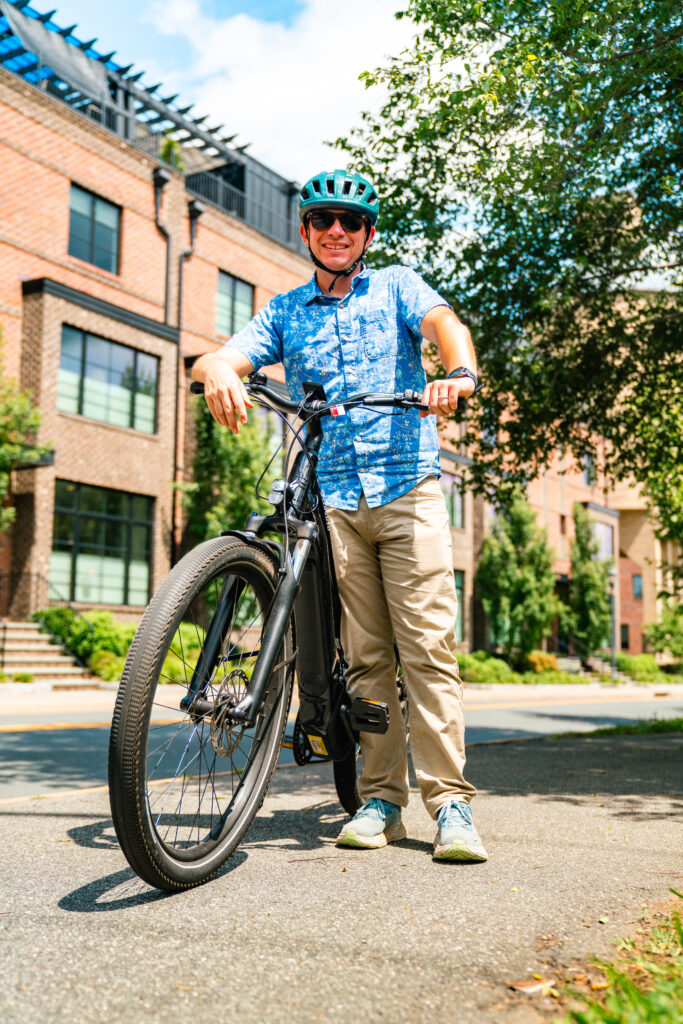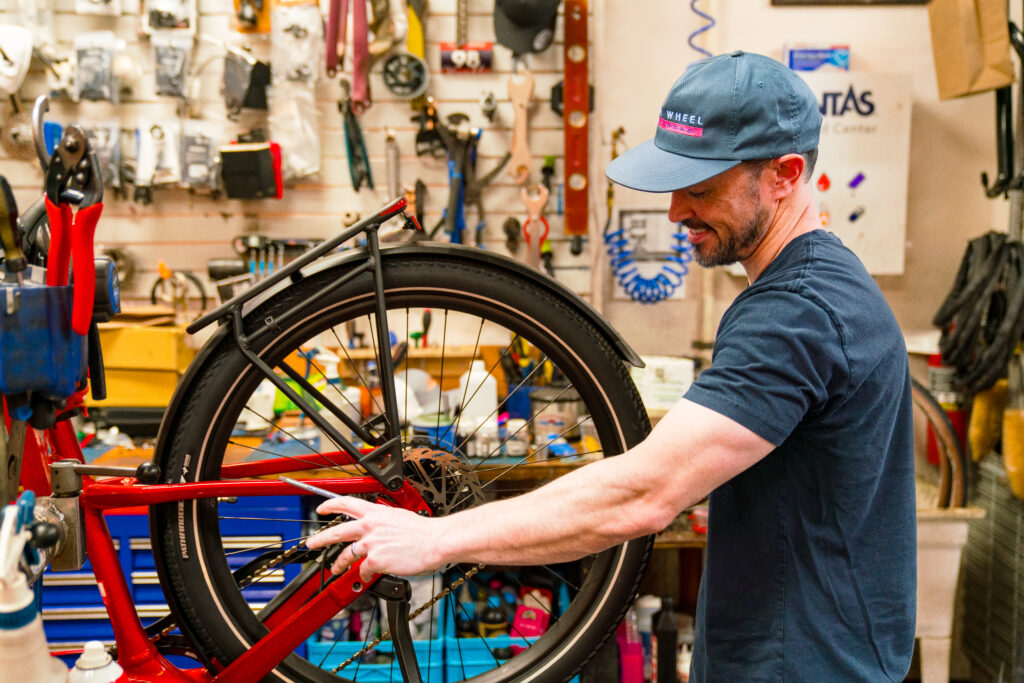UVA doctoral candidate T.C.A. Achintya needed a better way to get around. A new program from the City of Charlottesville made it happen.
“I had contemplated buying a regular bike, since I don’t own a car,” Achintya says. “But with how hilly C’ville can get, I never quite got around to it, since I could do most things via the city and the university’s bus networks, and I hated the idea of showing up to class or meetings sweating and out of breath.”
He looked at e-bikes—battery-packing bicycles that supplement human pedal power with a small electric motor—but says they seemed out of reach. “As a graduate student, it wasn’t an expense I could afford.”
But the city changed that in January, with the first in a series of quarterly drawings offering 25 lucky residents $1,000 toward an e-bike at any of three local bike shops. Out of nearly 1,200 applicants, Achintya won one of the city’s vouchers. “Without it,” he says, “I’d never have been able to afford an e-bike.” With the city’s help, Achintya was able to buy an older-model e-bike for just $200.
Now, “the e-bike’s completely changed how easily I can get around the city,” he says. “I end up using it either every day or every couple of days.” Instead of waiting for a bus, he travels on his own schedule, which cuts his commute time. And Achintya says the e-bike has made grocery shopping and other local trips far more convenient.
That’s the program’s main goal, says Thomas Safranek, the city’s e-bike and pedestrian coordinator and the voucher program’s administrator—providing an alternative form of transportation that’s safer and healthier.
“A hundred vouchers is not a lot,” Safranek says, regarding the program’s total annual offerings. “However, we’re a pretty small community, and if we put 20 new bikes on West Main headed downtown during rush hour, that does change the look and feel of that corridor. If folks are getting these e-bikes and they’re being seen more and more out on our streets, and there’s more bikes in general, it becomes a safer space for other bikers.”
In 2022, the U.S. Bureau of Transportation Statistics found that more than 60 percent of Americans’ daily trips were less than five miles, with more than 50 percent of trips involving three miles or less. Over such small distances, e-bikes offer a promising alternative to climbing in the car.
But while the e-bike voucher program seems like a good start, both Safranek and other local e-bike advocates say the city could and should do even more to make Charlottesville a friendlier place for two-wheeled transit.
Time to shine
Sales of e-bikes have surged in the U.S. and around the world in the past five years. According to the U.S. Department of Energy’s Vehicle Technologies Office, U.S. e-bike sales rose from 287,000 units in 2019 to 1.1 million units in 2022.
“They’re just fun to ride,” says Josh Carp, who runs the nonprofit Charlottesville E-bike Lending Library. “It’s a cliché, but when someone comes by and takes a test ride, they come back smiling. It’s hard not to have a good time on an e-bike.”
Safranek credits Carp and the activists at Livable Cville, among others, for bringing a voucher program to the city’s attention. Charlottesville modeled its program on the successful initiative that Denver, Colorado, launched in April 2022. Subsequent studies showed that participants there rode their new bikes an average of 26 miles a week, replacing 3.4 car trips. Sixty-five percent of recipients rode their e-bikes daily, while 90 percent rode at least once a week, and lower-income voucher recipients used their bikes roughly half again more often than standard recipients.
Charlottesville’s program, currently an open-ended pilot, is equally funded by $75,000 apiece from the city’s Sustainability and Neighborhood Development Services offices. “We chose it to be a subsidy as opposed to a rebate because we’re trying to reduce as many barriers as possible,” Safranek says. While he doesn’t yet have data on the income distribution of the winners, he says recipients have come from neighborhoods across the city.

How far does $1,000 go?
Winners have two weeks to pick up their voucher and three months to redeem it at one of three participating local bike shops: Blue Wheel Bicycles, Blue Ridge Cyclery, and Endeavor Bicycles. So far, Safranek says, only five or six vouchers from the first round have gone unused. Unredeemed vouchers expire and are added to the following quarter’s drawing, ensuring that the number of issued vouchers stays at 100 for the year.
While you can purchase e-bikes online for $1,000 or less, finding offerings in local shops at that price point is trickier. Mark McLewee at Blue Wheel Bicycles and Ben Algeroy at Endeavor Cycles both say their shops’ e-bike offerings start between $1,500 and $1,700.
“The bikes sold locally are far and away more reliable when it comes to e-bike issues, and they’re more easily repaired,” McLewee says. He says he stocks e-bikes from brands he knows he can get replacement parts from. “For folks that are using this as a primary means of transportation, it hopefully means very little downtime without your bike if something does go wrong.”
Safranek says he’s aware of the vouchers’ limitations, especially for lower-income recipients. In addition to the $100,000 of initial funding for the current voucher program, Charlottesville has set aside another $50,000 in hopes of offering even more generous financial help for people who need it. Safranek says the city government began holding initial planning meetings with other departments for such a program in mid-May.
Other benefits of e-biking
Putting more e-bikes on Charlottesville’s roads could help local residents breathe easier. Giving e-bike vouchers to just 4,700 residents reduced Denver’s annual carbon emissions by an estimated 2,040 metric tons.
A 2020 study from Portland State University estimated that replacing just 15 percent of car miles traveled each year could cut CO2 emissions by 12 percent. Factoring in the carbon costs of generating electricity, the study suggests that a single e-bike could cut CO2 emissions by 225kg per year. The average passenger vehicle emits 4,600kg of CO2 annually, according to the EPA.
“A battery is a much more efficient way to deliver energy than an internal combustion engine,” says Andrés Clarens, associate director of UVA’s Environmental Resilience Institute. Gas-powered engines lose a lot of their energy as waste heat. “You fill up your car with gas, and the vast majority of that, let’s say 80 percent, actually doesn’t ever help you move down the road.” According to Clarens, battery-electric vehicles lose only about 10 percent of energy while in motion.
Clarens also notes that building cities around car transportation comes with a lot of invisible costs, from the taxes necessary to build and maintain roads to the productivity costs of getting stuck in traffic, which Clarens says have been modeled at 30 to 40 cents per car, per mile.
“The costs of traffic are really significant,” he says, “and when you’re on a bike, you almost never find yourself in a traffic jam that you can’t get around. Some of those costs go away.”
“We’re in a period in the U.S. where we’re really challenging a lot of things, from Medicaid to the National Science Foundation,” Clarens says, in a tone of voice that suggests he doesn’t endorse those particular reconsiderations. “I think it’s reasonable to revisit this idea that getting around by car is the best choice. Because if you really sit down and look at it, there’s a lot of reasons why it doesn’t make as much sense as alternatives.”

E-bikes for everyone
If Charlottesville expands e-bike use, it could open up new mobility options for disabled citizens as well.
“An e-bike essentially makes biking an accessible form of transportation, even for people who are not especially athletic or not looking for a workout or even have significant mobility limitations,” says Lelac Almagor, the Washington, D.C.-based director of inclusion for cargo bike maker Bunch Bikes.
“The electric assist can do a little bit or a medium amount or all of the work for you, so that you’re still able to get some movement in, depending on how it’s comfortable for your body,” she says. “And you’re still able to get around in a sustainable way, but you’re not on your own for getting yourself and your cargo uphill.”
Three-wheeled bikes also add greater stability for disabled riders, Almagor says. Cargo bikes can carry disabled children or adults safely and comfortably, enabling more members of a family to enjoy biking together. (While some local shops do offer cargo bikes, neither Blue Wheel nor Endeavor currently offer electric trikes.)
Almagor says that in order to open up e-bike transportation, cities like Charlottesville need to invest in safer infrastructure. “There’s a very wide range of people for whom the infrastructure that we have asks them to take risks that are not reasonable.”
Making everyone safer
“I think if people had better bike infrastructure such that you could bike anywhere any day and feel safe, then the cost of the bike is easier to justify, because it’s more of a car replacement,” says Carp. “If you feel like you can’t bike on certain roads, certain places, certain times, then the cost is harder to justify because then you’re using it less of the time.”
“I’d love to see more bike lanes,” says Belmont resident Peter Hamilton, another of the city’s voucher winners. “On busier roads, it would be great if there was a barrier between the road and the bike lane. That way, cyclists can feel safer and more protected.”
Safranek says the city’s still working on making the bike infrastructure improvements that were laid out in its 2015 Bike-Pedestrian Master Plan. It’s currently focused on a protected bike lane on Fifth Street between Cherry Avenue and I-64.
“We would be removing a lane, and that lane would then become a two-way cycle track,” Safranek says. “You’re basically adding a protected shared-use path in that lane.” A public survey on the project ended at the beginning of May, and the city’s reviewing citizens’ suggestions on the plan before proceeding. “My hope is, by the spring of 2026, it’s on the ground.”
In the meantime, Safranek says the city’s learning from this first year of the voucher program, with an eye toward future improvements. “Is this reaching only a certain audience?” he says. “Could we maybe tweak this program to reach different audiences? Do we want to reach different audiences, [or] do we want to maintain our goal … to get as many bikes out on the street as possible?”
So far, the lucky few who’ve won a voucher seem happy with the program. “I really want to stress that the city initiative is amazing,” Achintya says. “I’ve been telling others about it, and I’m sure it’s made a huge difference to everyone who has been able to take advantage of it.”
Winner, winner
Any resident of the City of Charlottesville can enter the quarterly drawings for an e-bike voucher. Registration opens on the first day of January, April, July, and October, and the city accepts entries through the end of those months. You can apply online, or visit City Hall on Tuesdays and Thursdays between 9am and noon during the entry period to fill out a paper form. Employees of the city’s municipal government and their immediate families aren’t eligible for the program, but employees of city schools, local libraries, and other organizations not directly tied to city government can enter the drawing.
Winners are drawn on the first Wednesday in February, May, August, and November. A random drawing generator selects at least 25 winners—possibly more, if there are any unclaimed or unused vouchers from previous quarters. Once notified by email, winners have two weeks to pick up their vouchers in person from City Hall, and 90 days from the date of the drawing to redeem their voucher. You’ll need to show a government-issued ID, such as a driver’s license or passport, and proof of residency, like a utility or property tax bill, to receive a voucher.
The vouchers have no cash value, but they can be redeemed for $1,000 toward an e-bike at Endeavor Cycles (119 Maury Ave.), Blue Ridge Cyclery (722 Preston Ave. or 300 Connor Dr.), or Blue Wheel Bicycles (941 Second St. SE).
For now, the city’s imposing a lifetime limit of one voucher winner per household. But previous entrants who didn’t win are welcome to re-enter subsequent drawings.
Charlottesville’s e-bike voucher program provides some extra pedal power. Photo: Tristan Williams.






